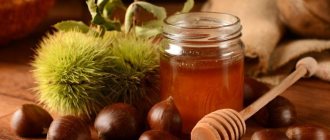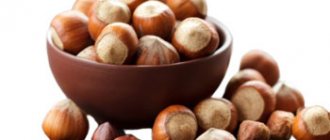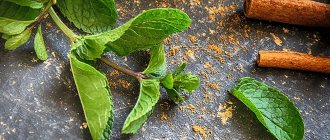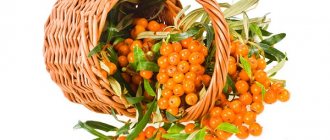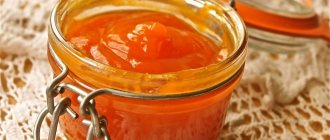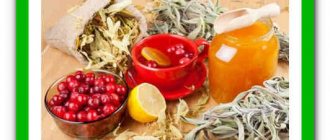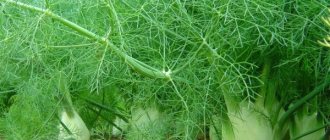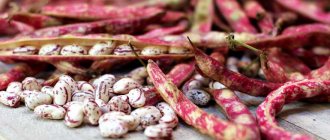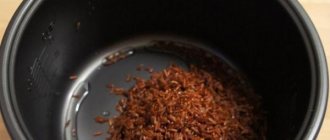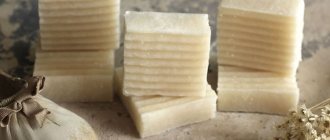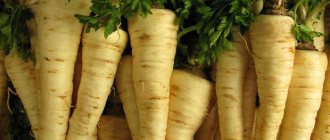Kinds
Beans are a heat-loving leguminous crop, the seeds of which germinate at a temperature of 10–12 degrees above zero. When frost occurs, the seedlings die.
Beans are sown on neutral or slightly alkaline soils, where row crops (tomatoes, cucumbers, cabbage, potatoes) were previously cultivated. A young plant is moistened extremely rarely (only during periods of drought), since early watering provokes the ovaries to fall off. After the buds open, the intensity of “moisture saturation” of the soil is tripled. In place of the fading flower, a pod gradually forms, inside which kidney-shaped seeds (5 - 12 pieces) ripen.
The length of the bean fruit ranges from 7 to 25 centimeters (depending on the plant variety).
There are 3 types of beans according to their structure:
- Hulling (grain). A characteristic feature is the presence of a parchment layer on the inside of the pod flaps. The color of the fruit varies from white to dark red with splashes. Shelling beans are grown mainly for their seeds.
- Semi-sugar. There is a parchment layer in bean fruits, but it is noticeable only when the grain is drying. Young soft seeds of the plant, which are at the stage of milky-waxy ripeness, are used for food.
- Asparagus (sugar). These beans are called vegetable beans because the green pod with underdeveloped soft seeds is used for food.
Interestingly, leguminous crops enrich the soil with nitrogen, as a result of which its fertility increases (due to the proliferation of nodule bacteria).
What are beans - description
As we already know, beans are a prominent representative of legumes that originally grew in the territory of modern Mexico and South America. Scientifically speaking, beans are a herbaceous crop with a climbing and creeping stem. It can reach 3 meters in length. As for the flowers, they resemble the delicate wings of small butterflies, moths, and the axillary type of inflorescence.
Fruits can be obtained only at the end of summer, approximately in the second half of July, in August, September. They can be in the form of green or yellow bean pods, or white, red, spotted and other shades. They are located in a container - inside a bean pod, reaching a length of up to ten to twenty centimeters, the shape of the seeds is ellipsoidal.
The culture itself is completely unpretentious. It can grow in both wet and dry soil, is not sensitive to heat and even cold, and can be grown in harsh climatic conditions. Beans take pride of place in the haute cuisines of the world - French, Italian, English, Russian, etc. It is used in the preparation of both first and second courses, salads. They even manage to create amazing sweet masterpieces, harmoniously combining beans with chocolate, sweet fruits, ice cream, etc. As they say, there are no limits to human abilities and fantasies.
Surely most of our readers know such names as Julien, pasta with beans, beef and mushrooms - a favorite delicacy of Italians, Paprikash, Liege salad. And what’s nice is that these masterpieces can be prepared without exception in an ordinary home kitchen. After all, legumes perfectly complement the taste of red, white meat, poultry, and fish. Some Mediterranean restaurants and bars offer seafood dishes that harmonize perfectly with the taste of soft and tender beans. And the ancient Greek bean soup was a dish of the poor, but very quickly migrated to the tables of the rich nobility.
Interesting fact: according to statistics, the biggest fans of beans are the British. In a year they eat as much as the whole world. Following them, the culture we are studying is most often used in their cuisine by the Japanese, Chinese, and Koreans. What’s noteworthy is that these countries make amazing candies, as well as bean flour.
The exceptional value and rich vitamin and mineral composition became the reason for including beans in shampoos, ointments and powders.
Interesting: The benefits and harms of turnips for the human body
Chemical composition
Beans are a protein product that belongs to the category of complex carbohydrates.
The energy value of 100 grams of legume seeds is 335 kilocalories. Interestingly, the same amount of green beans contains only 30 kilocalories. Table No. 1 “Nutritional value of common beans”
| Name | Nutritional value per 100 grams of product, grams |
| Starch | 43,2 |
| Water | 14 |
| Cellulose | 3,8 |
| Pectin fibers | 3,6 |
| Monosaccharides | 3,0 |
| Ash | 0,95 |
| Saturated fatty acids | 0,90 |
| Fats | 2,0 |
| Squirrels | 21,0 |
| Carbohydrates | 54,0 |
Table No. 2 “Chemical composition of common beans”
| Ingredient name | Element concentration in 100 grams of fruit, milligram |
| Vitamins | |
| Vitamin B1 (thiamine) | 0,46 |
| Vitamin B2 (riboflavin) | 0,16 |
| Folic acid | 0,085 |
| Vitamin E (tocopherol) | 0,6 |
| Vitamin B3 (niacin) | 2 |
| Vitamin B5 (pantothenic acid) | 1,2 |
| Vitamin B6 (pyridoxine) | 0,19 |
| Vitamin K | 0,0056 |
| Vitamin C | 18,8 |
| Macronutrients | |
| Potassium | 1090 |
| Phosphorus | 470 |
| Sulfur | 150 |
| Calcium | 140 |
| Magnesium | 100 |
| Chlorine | 58 |
| Microelements | |
| Iron | 5,9 |
| Zinc | 3,2 |
| Manganese | 1,32 |
| Aluminum | 0,64 |
| Copper | 0,578 |
| Bor | 0,49 |
| Nickel | 0,173 |
| Silicon | 0,092 |
| Fluorine | 0,04 |
| Molybdenum | 0,039 |
| Sodium | 0,038 |
| Selenium | 0,025 |
| Cobalt | 0,0182 |
| Iodine | 0,012 |
| Chromium | 0,01 |
Beans contain amino acids (arginine, tyrosine, lysine, leucine, tryptophan, histidine), organic acids (malic, manolic, citric), flavonoids and tannins.
Interestingly, beans “compete” with fish and meat in terms of the amount of easily digestible proteins.
What are the benefits of beans for men?
Our men work day and night to provide their halves with a comfortable existence. It so happens that it is on their shoulders that the physical load falls, and this requires strength, the same physical strength. Where to get them from - from meat. You can’t constantly eat meat products, so it’s important to pay attention to healthy, unique products from nature that cost pennies and are available at any time of the year.
- In recent years, for various reasons - due to poor ecology, bustle, constant stress, poor nutrition, a colossal influx of chemicals into food and the environment, men have become more likely to suffer from cancer and inflammatory diseases of the genitourinary system. What is especially frightening is that terrible illnesses have become “younger”; young people are suffering from them.
- Also, the passion for beer plays a big role in this process; even at a very young age, children develop “beer” bellies. Thus, visceral fat is formed - the main enemy of male potency and its organs. The hard fibers of beans and similar products do not give a chance for the accumulation of fat mass, restore muscle structure and, of course, erectile function of a person.
Vitamin E - tocopherol, is involved in the activation and stimulation of sperm, improves their quality. All this has a great effect on both a man’s sex life and his health in general.
Beneficial features
Beans are an excellent source of protein, iron, potassium, magnesium, phosphorus and zinc.
What are its benefits for humans?
Reduces elevated blood sugar concentrations (due to arginine content).- Participates in the regulation of salt metabolism (potassium is “responsible” for the osmotic pressure of intracellular fluid).
- Calms the nervous system, increases resistance to stress (due to the presence of B vitamins and amino acids).
- Regulates hormonal levels (due to the presence of protein structures).
- Improves vision by optimizing the energy exchange of the eye and prevents photo-oxidation in the retina (these processes are controlled by carotenoids and B vitamins).
- Prevents the deposition of tartar in the mouth (due to the presence of calcium, phosphorus and potassium).
- Accelerates the regeneration of tissues and mucous membranes of organs (due to the content of fat-soluble vitamins A and E).
- Increases male potency (by maintaining the natural level of sex hormones, for which zinc is “responsible”).
- Relieves inflammatory processes in the kidneys and liver (organic acids have an antimicrobial effect)
- Normalizes metabolic processes, prevents atherosclerosis (saturates the body with essential nutrients, prevents hypovitaminosis).
- Strengthens the secretion of gastric juice.
- Removes toxins from the body, supplying pectin and fiber to the body.
- Strengthens the immune system, potentiates the synthesis of red blood cells, prevents the development of anemia (due to the presence of iron).
- Protects genetic cells from mutations (natural antioxidants neutralize the effects of free radicals that cause DNA damage).
- Accelerates the excretion of urine from the body, reduces swelling (potassium normalizes the correct water-salt balance).
- Strengthens bones and teeth (due to calcium and magnesium content).
Beans are used in dietary nutrition for heart rhythm disorders, diabetes, atherosclerosis, edema of renal origin, hypertension, rheumatism, nervous overexcitation, salt metabolism dysfunctions, tuberculosis, cystitis, urolithiasis. In addition, beans are included in the menu of weight loss programs.
The benefits of beans for the body
Among the beneficial properties of beans for the human body, several main ones can be identified. Namely, this product:
- regulates intestinal function, eliminates problems with bowel movement, and promotes the timely removal of toxins;
- reduces cholesterol, thereby strengthening blood vessels and reducing harm to the cardiac system;
- relieves headaches, relieves fatigue, including chronic fatigue;
- has a beneficial effect on the respiratory system - regular consumption of beans helps relieve asthma symptoms;
- helps with joint diseases - relieves pain and inflammation in arthritis;
- improves immune resistance and helps cure colds;
- has a beneficial effect on the nervous system and brain, prevents the development of Alzheimer's disease in old age;
- strengthens bones, reduces the risk of osteoporosis;
- improves the condition of the skin and generally rejuvenates the body;
- helps with eye diseases, in particular cataracts.
We recommend reading: What are the benefits of boiled beets for the body?
The benefit of beans for the human body is that it lowers glucose in the blood. The product is highly recommended for use in diabetes mellitus.
Women
The benefits and harms of beans for a woman’s health are expressed in the effect of the product on the reproductive system. Beans reduce the harm from blood loss during menstruation, since they maintain hemoglobin at the required level and improve well-being during pregnancy.
The beneficial properties of beans for women also include the fact that the amino acids in this product strengthen the immune system and normalize the functioning of the endocrine system. The product protects women from the development of cancer, to which the fairer sex becomes especially susceptible as they age.
Men
The benefit and harm of beans for men is that the protein-rich product helps build muscle tissue. In addition, the product contains vitamins responsible for the reproductive functions of men - consumption of beans has a beneficial effect on potency and promotes successful conception.
The benefits of beans for a man’s body are also expressed in their positive effects on the intestines, blood vessels, heart and liver. The product protects the male body from atherosclerosis, strokes and heart attacks. Regular consumption of beans helps get rid of fat deposits that occur due to lack of physical activity.
Use in folk medicine
The seeds, pods and buds of beans are used for medicinal purposes.
Let's look at the most popular recipes:
- Infusion of bean leaves for hypertension, gout, diabetes. The healing extract is prepared as follows: grind 20 grams of dried bean husks, then pour half a liter of boiling water. After this, the broth is infused in a thermos for 40 minutes. The drug is taken 15 minutes before meals, 100 milliliters four times a day. The course of treatment is 21 days.
- Powder from bean fruits for the treatment of burn wounds, weeping eczema, skin rashes. The dry seeds of the plant are ground into fine dust. To speed up the regeneration of the dermis, sprinkle the damaged areas with the resulting powder 3 times a day.
- A decoction of bean leaves for rheumatoid arthritis. 20 grams of dry raw materials are poured with 250 milliliters of water. After this, the composition is boiled over low heat for 10 minutes. The decoction is taken 100 milliliters three times a day 40 minutes before meals.
- Bean husk tea for edema, urolithiasis, and kidney inflammation. The healing decoction is prepared immediately before use. To do this, 15 grams of dry leaves are poured with 250 milliliters of boiling water. The tea is steeped for 5 minutes, then filtered and drunk. The healing extract is consumed in between meals (2 – 3 times a day). In addition, bean tea is used to prevent urolithiasis.
- Bean puree for atherosclerosis, heart rhythm dysfunctions. Before preparing the “porridge,” the beans are soaked in water for 6–8 hours. Then the seeds are thoroughly washed and placed on low heat. After boiling, the beans are transferred to a pan with “fresh” water, in which the beans are cooked until fully cooked. Warm fruits are mashed with a fork, salt and butter are added to taste. To eliminate functional disorders, the daily menu includes at least 150 grams of dietary bean puree.
- Herbal tea to loosen kidney stones. The components of the medicinal collection are bean leaves, blueberry leaves, blackthorn, yarrow herb, horsetail, St. John's wort. Herbs are mixed in equal proportions, with the exception of the last two, which are taken 2 times more. After this, 20 grams of the collection are poured with 300 milliliters of cold water and infused for 5 - 7 hours in a thermos. The herbal extract is then brought to a boil and immediately cooled.
The healing potion is taken 120 milliliters 3 times a day before meals. If lower back pain occurs, the tea dose is reduced to 60 milliliters. After the discomfort in the back disappears, the daily portion of the infusion is adjusted to normal.
- Blood purifying tea. To create a collection you will need 20 grams of bean leaves, 15 grams of birch leaves, 10 grams of yarrow, 5 grams of horsetail, 5 grams of peppermint. After mixing the herbs, 20 grams of dry raw materials are poured with 400 milliliters of boiling water. The composition is left in a warm place for 2 - 3 hours. Take 100 milliliters of tea 4 times a day.
- Bean juice for the treatment of chronic pancreatitis. Nectar is prepared from the fresh fruits of a legume plant. To reduce inflammation in the pancreas, take the juice at least 4 times a day, 70 milliliters. If necessary, add natural honey (5 - 10 milliliters) to the liquid.
Remember, it is advisable to use these recipes only after consultation with your family doctor.
Can children eat beans?
Let us immediately note that beans cannot be included in a baby’s diet until he is 3 years old. It's all about the fibers, they are too tough for the children's intestinal tract. And even then, you need to prepare the product very responsibly - soak it in water for at least 5-6 hours, then cook until completely cooked and grind it into puree. Give children tiny portions - 1-2 tablespoons, starting with a teaspoon.
As for the green pods, our kids simply adore them. This does not mean that they need to be fed from early childhood; wait until they are one year old. Rinse thoroughly, boil and grind into puree. A serving is no more than 1-2 teaspoons.
Important: before feeding your baby, check his individual tolerance to the product. Give a tiny portion and pay attention to whether there is a rash, swelling, redness, itching, anxiety, tearfulness, or difficulty breathing. The presence of symptoms indicates that the child is intolerant to the product, which should be excluded for several years. You must immediately consult a doctor.
The antioxidants contained in the product improve the baby’s mental abilities, develop memory, vision, hearing, and participate in the regulation of the nervous and cardiovascular systems. With regular consumption of beans, a child’s sleep improves, anxiety and irritability go away.
Contraindications
For culinary purposes, bean seeds and pods that have undergone heat treatment are used. However, with weakened intestinal microflora, even boiled beans cause gas formation, bloating and heaviness in the abdomen. To neutralize the side effects, beans are consumed with fresh herbs, and fennel or dill seeds are added to the water where the fruits are boiled.
Beans are excluded from the menu for the following diseases:
- jade;
- gastritis;
- colitis;
- gout;
- stomach ulcer;
- acute pancreatitis;
- increased acidity of gastric juice;
- cholecystitis.
In addition, pregnant women, young children and the elderly should not consume beans.
Remember, consuming fresh fruits of the plant is strictly prohibited, since they contain toxic substances.
Can beans be consumed by pregnant and lactating women?
The benefits of beans for pregnant women are great - the product protects women from the development of anemia, reduces toxicosis, and prevents constipation. The beneficial properties of beans support a woman’s muscle tone and protect the expectant mother from cramps. The product also benefits the child - the fetus receives all the vitamins and minerals necessary for normal development.
However, beans in excess quantities can be harmful - they cause flatulence and discomfort in the intestines. Therefore, when using them you need to remember to be careful.
As for the lactation period, it is recommended to consume green beans while breastfeeding; they will bring the greatest benefit. To prevent the product from causing harm, you need to eat it little by little and no more than three times a week. A young mother should carefully monitor the baby’s reaction - if the product harms the baby, it will have to be discontinued.
Application in cosmetology
For many centuries, beans have been successfully used in cosmetology. In ancient times, flour was obtained from it, on the basis of which women's powder was created. Interestingly, the Egyptian queen Cleopatra included beans in her weekly body care routine. Currently, beans are used as an anti-age agent for mature, aging and problematic facial skin.
What are the benefits of bean masks?
- Nourish. Beans intensively soften facial skin, eliminate redness, and restore the hydrolipidic mantle of the dermis (due to the content of vitamins, amino acids, and natural antioxidants).
- Lighten up. Considering that beans contain organic acids, products based on them are used to even out skin tone and reduce the appearance of freckles and age spots.
- They pull up. Bean masks help in the “fight” against fine wrinkles and also improve facial turgor.
- Cleanse. Home remedies with beans are used to dissolve blackheads on the skin (comedones) and dry out acne.
Nourishing mask for combination dermis
Ingredients:
- 20 grams of boiled carrots;
- 60 grams of boiled beans;
- 25 milliliters of sour cream;
- 10 milliliters of lemon juice.
Carrots and beans are crushed to a mushy state, and then combined with the rest of the ingredients. The composition is thoroughly mixed. The finished mixture is applied to the skin for 15 – 20 minutes. With regular use of the mask, the dermis acquires a fresh, healthy shade, pigment spots are lightened, and the “microrelief” of the face is evened out.
Purifying bean mask
Components:
- 60 grams of boiled beans;
- 50 milliliters of dill water (30 grams of herb are poured with 50 milliliters of hot water, left for 15 minutes).
The beans are mashed with a fork and then combined with dill infusion. The finished composition should resemble thick sour cream in consistency. The mask is applied to cleansed skin, avoiding the area around the eyes and lips, for 15 minutes. After this, the mixture is washed off with dill decoction diluted half with water.
Firming face mask with beans
Active components:
- 30 grams of boiled red beans;
- 35 grams of oat flour;
- 8 milliliters of lemon juice;
- 30 milliliters homemade cream.
These components are mixed and then applied to the face, neck and décolleté. After 20 minutes, the mixture is washed off with warm water. The mask is most effective for mature, aging dermis.
Composition for oily skin
Ingredients:
- 30 grams of bean puree;
- 1 egg white (whipped until foamy);
- 15 grams of wheat flour.
These components are ground and then applied to cleansed skin. After 20 minutes, wash with warm water. The mask is used to eliminate oily shine, cleanse pores, and even out facial tone.
Intensively cleansing mask
The mixture includes:
- 15 grams of grated cucumber;
- 15 grams of cottage cheese;
- 30 grams of bean puree.
The specified mixture is applied to a moistened face, gently massaging problem areas. Leave the mask on the skin for 15 minutes, then wash off. To obtain a lasting result, the procedure is performed every 2 days.
Helpful Tips:
- The optimal frequency of using masks is 1 – 2 times a week.
- For cosmetic purposes, it is better to use white beans.
- The beans are boiled immediately before preparing the mask.
- To obtain bean puree, the warm product is passed through a fine sieve.
- Before the procedure, thoroughly cleanse the skin.
- To achieve maximum effect, the ingredients are added to warm beans.
- The mixture is applied to the skin in a thick layer, avoiding the area around the eyes.
- It is advisable to use the water in which the beans were cooked to wash your face.
- Wash off the mask with warm water, after which the dermis is toned and a nourishing cream is applied.
Along with cosmetic masks, it is advisable to use professional products containing bean extract. Namely: serum for correcting skin tone (Mary Kay), soothing skin gel with black bean extract (Beautykor), whitening face cream mask with green beans (Meitan), fabric mask based on fermented beans (Innisfree).
The benefits and harms of sprouted beans
In recent years, sprouted grains and beans have been gaining popularity - this list also includes beans. The benefit of bean sprouts is that such beans contain much more vitamins B, C and E. Sprouts have antibacterial and rejuvenating properties, effectively tone the body and prevent the occurrence of cancer. Consuming them is useful for weight loss, maintaining good condition of hair, skin and nails.
However, the benefits of raw beans with sprouts are not always clear. If you abuse this product, it will lead to a decrease in blood pressure, flatulence and diarrhea.
How to sprout beans at home
It is not necessary to buy a sprouted product in specialized stores - you can get sprouts at home. The process looks like this:
- beans intended for germination are carefully sorted, leaving only the healthiest grains, and washed several times;
- clean beans are placed in a container with a perforated bottom and placed in another larger container where the water will drain;
- The bottom of the germination container is covered with gauze folded in several layers, beans are poured on top - in a fairly thin layer;
- The beans are poured with water so that the liquid almost covers them on top, covered with another piece of folded gauze on top and put in a warm place for several days.
As liquid accumulates in the lower container, it will need to be drained. After a couple of days, the first shoots should emerge - this means that you need to continue watering. After a few more days, the sprouts will become longer, after which their beneficial properties can be used in food.
Important! Not all varieties of beans are suitable for sprouting - it is recommended to sprout only golden or Indian beans.
The red and white varieties of the plant contain too many toxins, which are harmful and disappear only with prolonged cooking.
How to use sprouted beans
The benefits of bean sprouts are most clearly evident when adding the product to salads. In combination with vegetables and herbs, sprouted beans have a particularly beneficial effect on the body.
Sprouts are also added to soups and side dishes for meat and fish dishes. Sauces are made from sprouted beans; sometimes the product is even found in baked goods. The increased content of vitamins in sprouts enhances the beneficial properties of any dish.
Cooking tips
To speed up the cooking of beans, reduce the concentration of harmful oligosaccharides, and improve their absorption in the intestinal tract, the beans are subjected to preliminary preparation.
Initially, the product is boiled for 2 minutes over low heat. Then cover the pan with a lid and leave on the stove for 2 hours. After this, the beans are soaked in cold water and left for 6 to 12 hours.
Regardless of the method of pre-treatment of seeds, beans are washed with running water before cooking. After this, the swollen fruits are poured with cold liquid and boiled over low heat. For first courses, the duration of cooking beans is 10-20 minutes, for side dishes - 30-60 minutes. The beans are most often cooked until half cooked (in a small volume of water), and then added to the broth or fried vegetables. It is better to place tomatoes, tomato paste, and sauces in the dish after cooking, since the acid increases the cooking time of the beans.
Regular beans are salted 10 minutes before the end of cooking, and asparagus fruits are salted after boiling. This will preserve the color of the pods.
Remember, cooking time for beans depends on their freshness. Therefore, when purchasing beans, pay attention to the packaging date of the raw materials.
White bean varieties
Beans differ from other products in their variety of choices. Among the many varieties of white beans, you can find large, small and medium-sized specimens. The variety determines the method of use.
Let's look at a few popular varieties:
- Chali. The fruits are large in size and soft after cooking. They are used for preparing first courses, side dishes and salads. The beans have a trapezoid shape, and the average cooking time is 45 minutes.
- Black eye. The most tender variety among all crops. The beans have a thin shell, so they cook quickly. In folk medicine, these beans are used to prevent breast cancer.
- Nevi. Beans with this name are considered the oldest known variety. The fruits are similar in appearance to peas, but have a higher fiber content. Regular consumption of these beans helps lower blood sugar levels.
- Moscow white green-pod. The species was bred specifically for cultivation in central Russia. Beans are resistant to many diseases and temperature changes.
- White flat. A little in demand bean variety. Due to the increased content of microelements in beans, it is actively used in folk medicine.
- Lotus. The fruits of this bean are dense and fleshy. The variety is in demand among gardeners due to its high yield.
If a legume is planned to be used to treat any diseases, it is initially recommended to consult and obtain approval for such therapy from a leading specialist.
Conclusion
Beans are a natural source of easily digestible protein and an excellent alternative to meat. It contains essential amino acids, vitamins, antioxidants, organic acids, micro- and macroelements.
To prevent functional disorders, beans are included in the menu 2–3 times a week (100–150 grams each). In addition, beans are an “indispensable” product for people suffering from rheumatism, diabetes, intestinal disorders, bronchial pathologies, genitourinary dysfunctions, and neurological diseases. Considering that the “protein” plant has a low calorie content, it is successfully used in dietary nutrition, especially in the fight against excess weight. However, to get maximum benefit from the product, it should be soaked in cold water for 6 to 8 hours before cooking.
More fresh and relevant information about health on our Telegram channel. Subscribe: https://t.me/foodandhealthru
We will be grateful if you use the buttons:
Harm of beans and contraindications for use
Despite all the benefits, in some situations the product can cause harm. Beans have the most dangerous properties in their raw form - they contain lysine, which is toxic to the body and disappears only after heat treatment.
Contraindications for using the product are:
- gastritis, ulcers and colitis in acute conditions;
- gout and pancreatitis;
- severe liver diseases;
- cholecystitis;
- cholelithiasis;
- flatulence.
Excessive consumption of the product is harmful because it leads to increased gas formation due to the high fiber content.
Losing weight with beans
Is there a bean diet? Yes, it exists and it is very effective. Moreover, the product can be used both as part of other items and as a mono-diet. Legumes are easy to store; just put them in a sealed bag and keep them in a dry, dark and cool place. Even better, in order not to waste time cooking it every time, you can cook a large amount in a cauldron. Boil until tender, place in food containers or bags and keep in the freezer. In this form, the product will not lose a single gram of nutrients and will only bring health. We suggest you study several useful recipes for burning extra pounds.
